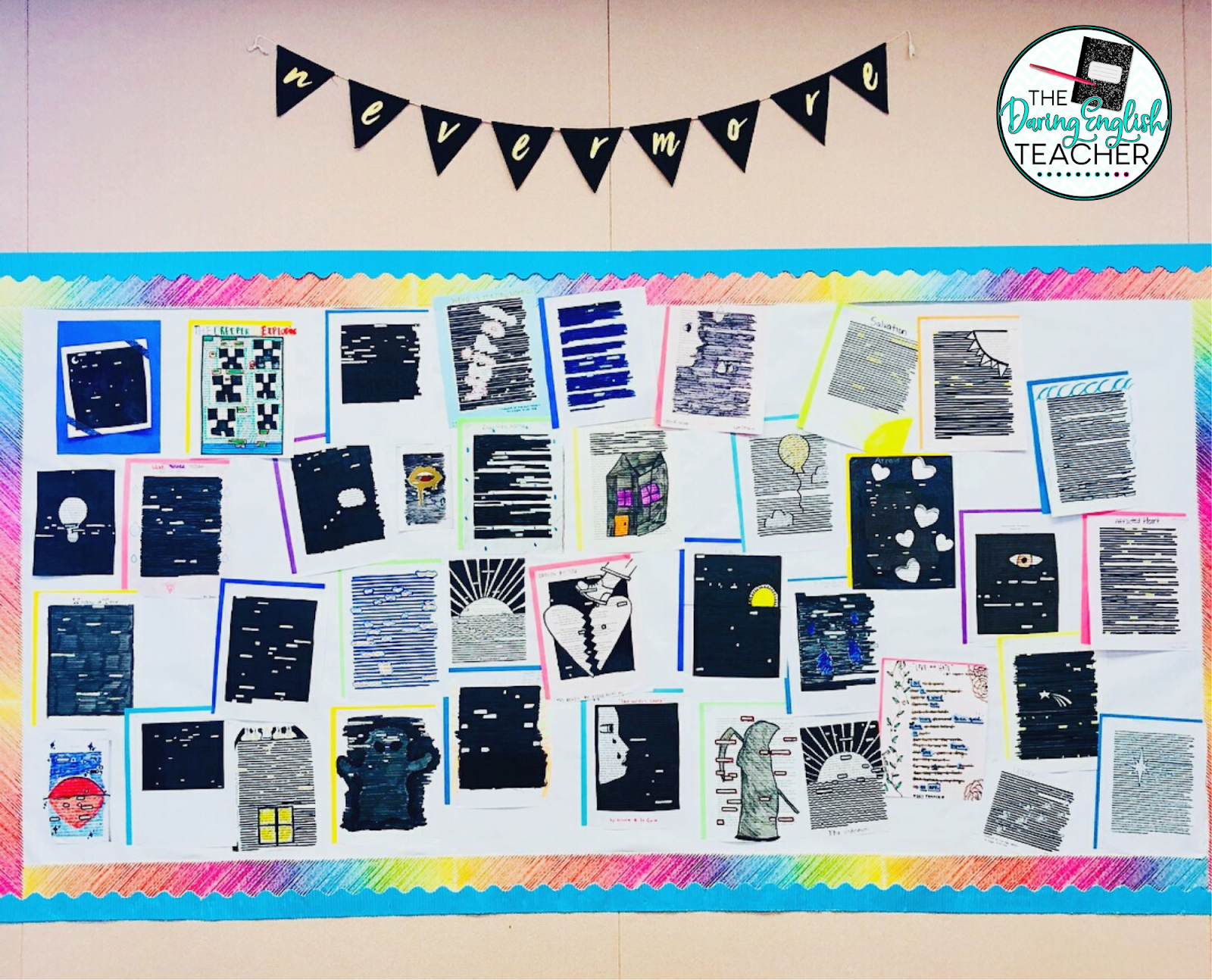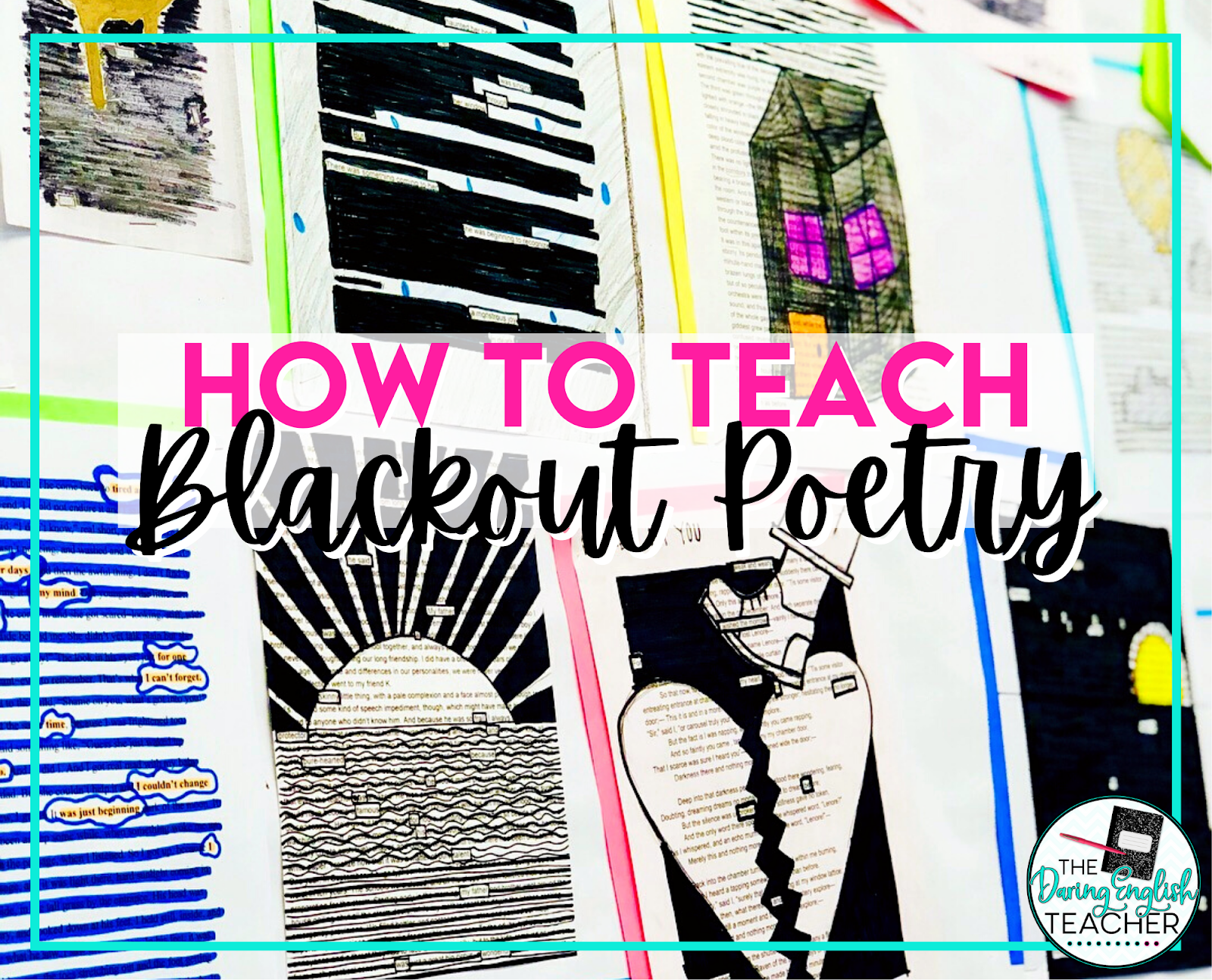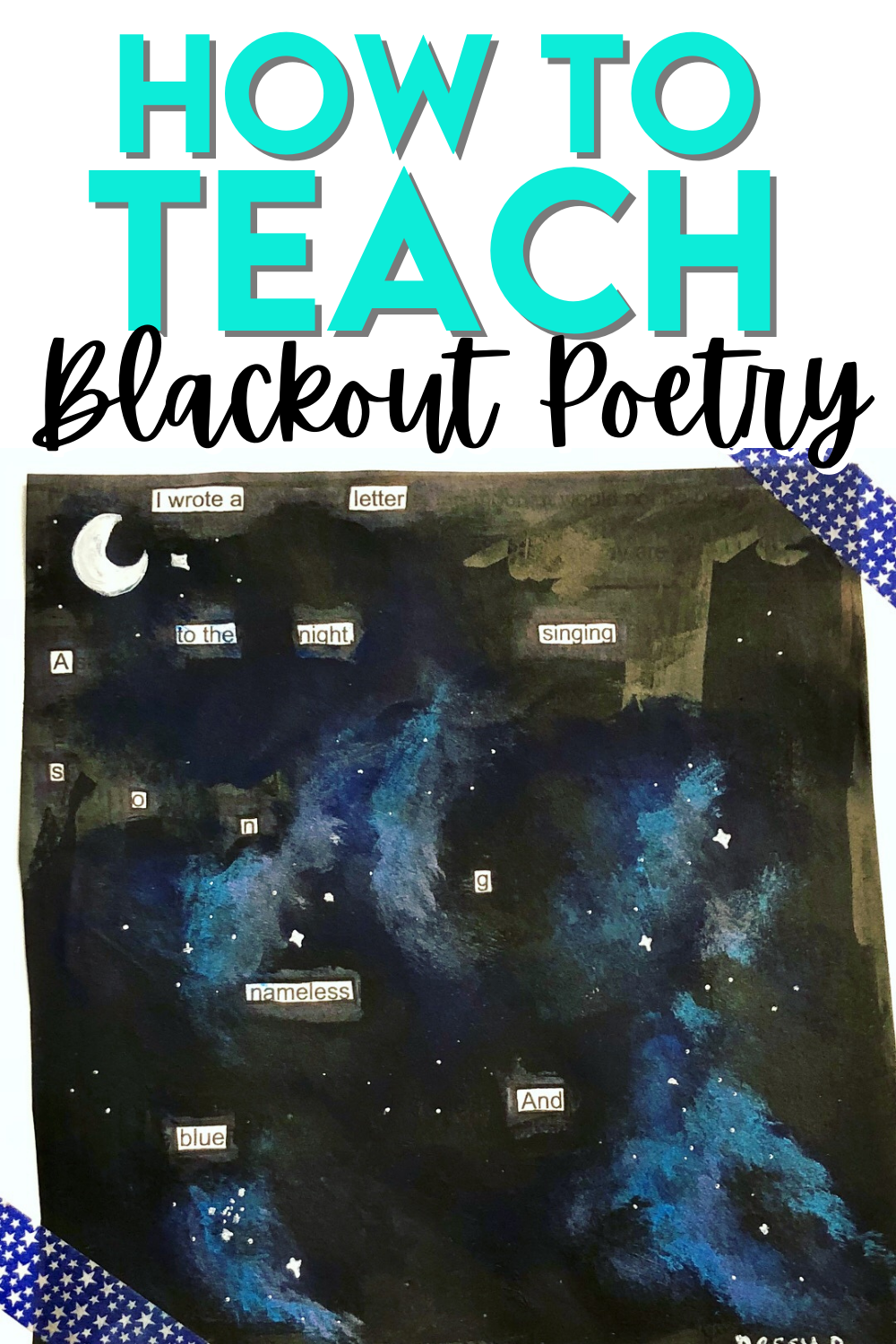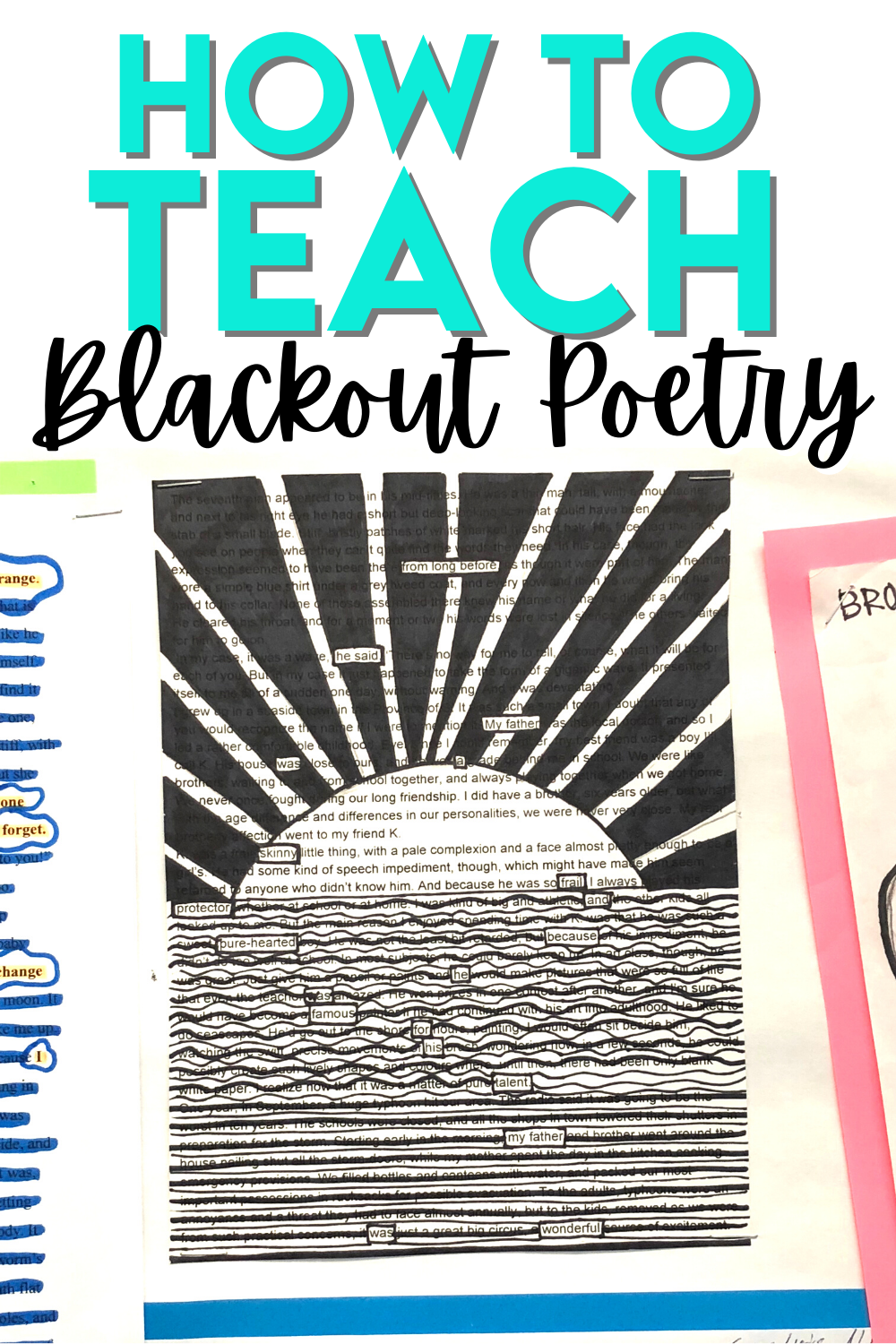If you are looking for a fun and engaging way to hook your students on poetry? Consider teaching blackout poetry in your ELA classroom. This step-by-step guide to teaching blackout poetry will help you discover how to teach blackout poetry and deliver a great lesson and unit to your middle school ELA or high school English students.
- Teaching blackout poetry as part of your poetry unit is a simple and effective way to engage students in poetry.
- Blackout poetry is a form of found poetry that can easily be assigned in the middle school ELA or high school English classroom.
- Students do not need many supplies to create blackout poetry. You can either ask for old books the library is getting rid of or print out text for students to use.
How to Teach Blackout Poetry
What is blackout poetry?

Blackout poetry is a created form of poetry where the poet uses pages of text and blocks out some of the words to form a new poem. The remaining words on the page form the blackout poem. Blackout poetry is a type of “found poetry,” meaning it is found somewhere because poetry is everywhere.
I typically teach blackout poetry toward the end of my poetry teaching unit because students understand poetic elements and devices. After teaching blackout poetry to your students, they’ll be hooked!
Supplies needed for blackout poetry
Creating and teaching blackout poetry can be as complex or straightforward as one makes it. All your students will really need is a writing utensil, a black Sharpie works best, and a page of text. I like to encourage students to add artistic elements into their blackout poetry, and students may also choose to use a variety of art supplies.
There are quite a few options when it comes to gathering the text for students to use for their blackout poems. First, check-in with your school library. Many school libraries regularly purge older books to make room for new inventory. If your school library is giving away old books, grab some when you can because students can use those pages to create their own blackout poems.
If tearing pages from books is not an option for you is to use old newspaper clippings or print off PDF pages from novels you’ve read this year, novels students have read in previous grades, or pages from their favorite books. You can even print off informational text! The possibilities really are endless.
How to Teach Blackout Poetry: Getting started with blackout poetry in the classroom
Once you’ve gathered the necessary supplies for incorporating blackout poetry in your secondary ELA classroom, it is time to get started. Before setting your students loose to begin their own poems, you’ll first want to show them examples of blackout poems. This helps ensure that students have a good idea of what is expected of them. Then, you’ll want to teach students the simple steps to creating blackout poetry.
Teaching Blackout Poetry: Six essential steps to creating blackout poetry
- Scan the text
- Identify a variety of high-interest, impactful words that will help you develop a theme
- Read the poem in its entirety to look for connecting words
- Read the selected words aloud
- Finalize the poem by outlining the selected words
- Blackout all of the unused words
Continue reading to see a more in-depth and step-by-step look at these six steps to teaching and creating blackout poetry. In addition to sharing the steps for creating blackout poetry with your students, you’ll also want to make sure that you share guidelines for your students so that they create their poems. This will help your students apply the poetic terms they’ve learned to the blackout poems they make.
Some of the poetic elements you can have your students include are listed below. I suggest offering this list as a choice board. Have students include a predetermined number of the elements from the list in their poem. It isn’t necessary that they include every single item.
If you are looking for a pre-packaged and ready-to-go blackout poetry lesson, here is the link to my Blackout Poetry Teaching Unit on TPT. This teaching blackout poetry unit is ready for classroom use to help you help your students create the best blackout poems possible!
Poetic devices for blackout poetry
- Theme*
- Tone
- Mood
- Imagery
- Figurative language
- Word choice
- Symbolism
Recommendation: Theme should be an element present in every poem. When I am teaching blackout poetry in my classroom, I make sure students know this.
Teaching Blackout Poetry: Diving deeper in blackout poetry
Now that you are ready to introduce your students to blackout poetry, it is time to start the six steps for creating blackout poetry.
The first step is to scan the text. Your students don’t need to read the entire page all at once when they first start blackout poems. Instead, it is best if they quickly scan the text. As students are scanning the text, instruct them to keep an eye out for interesting words that they can use that will help them develop a theme. As students scan the text, they should lightly circle the words they find.
Once students scan the text and select high-interest words, instruct them to go through the words and choose their favorite words. These words should work together to form a cohesive theme. Make sure that your students know that these words won’t make sense together at this point in the process. Students might worry that they don’t have a poem yet, but that is okay. What they have at this point should read as a list of words.
After students have a list of words identified on their page, it is time to instruct them to read the entire page closely. As students read the page, they should read it closely and intentionally to find connecting words that will help them link together their high-interest words. You might find that students need to complete this step a couple of times to find the connecting words and make sure their blackout poem makes sense.
Now that your students have gone through and identified the words they think they will use, it is now time to instruct them to read their poems aloud. This step can either be done individually, in partners, or in small groups. When students read their blackout poems aloud, they will self-check to see if their poems make sense.
At this point in the project, some of the students might need to go back to the previous step and read the poem again to find new words. If students are happy with their poems after they read them aloud, however, instruct them to outline their chosen words. It is best to use a Sharpie or felt pen to outline their words.
Once students have their chosen words completely outlined, the sky is the limit for finalizing their poems. I like to encourage students to go beyond blacking out a poem with a single color. While every word that isn’t used should be colored or filled in, I like to encourage my students to include imagery from their poem onto the page.
They can add illustrations over the unused words to bring their poems to life! Students can use colorful markers, watercolors, oil pastels, and essentially any type of art medium. Don’t forget to instruct students to include a title at the top or side of the page.
To wrap up this project, I like to dedicate class time to sharing their blackout poems. You can do this in various ways: individual presentations, small group presentations, and even as a gallery walk.




